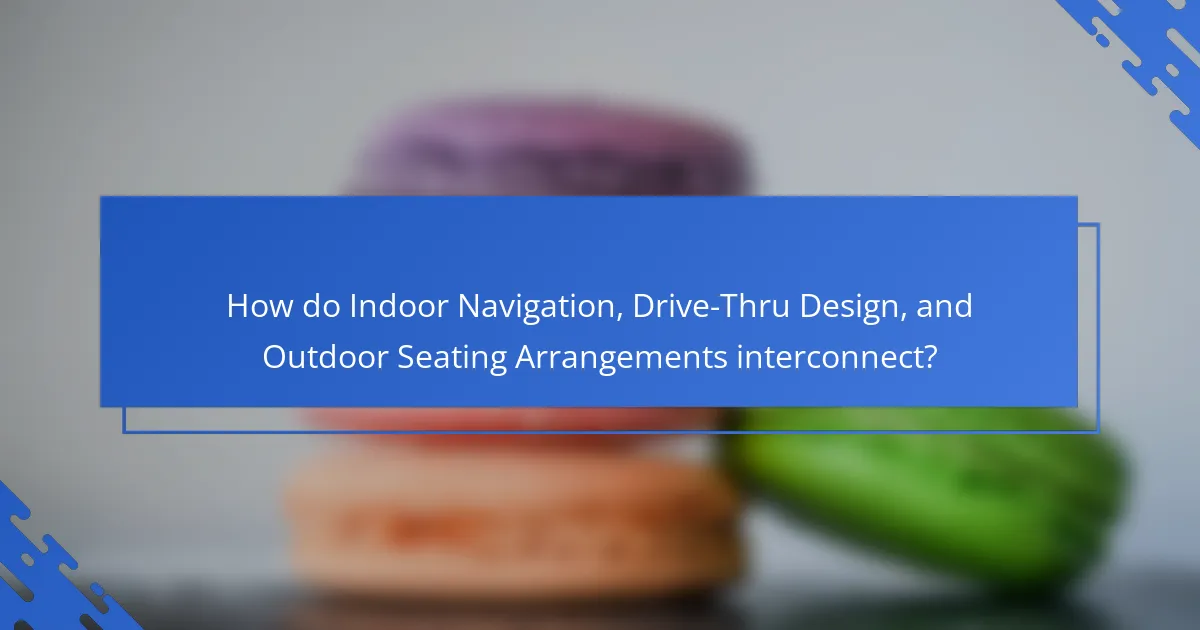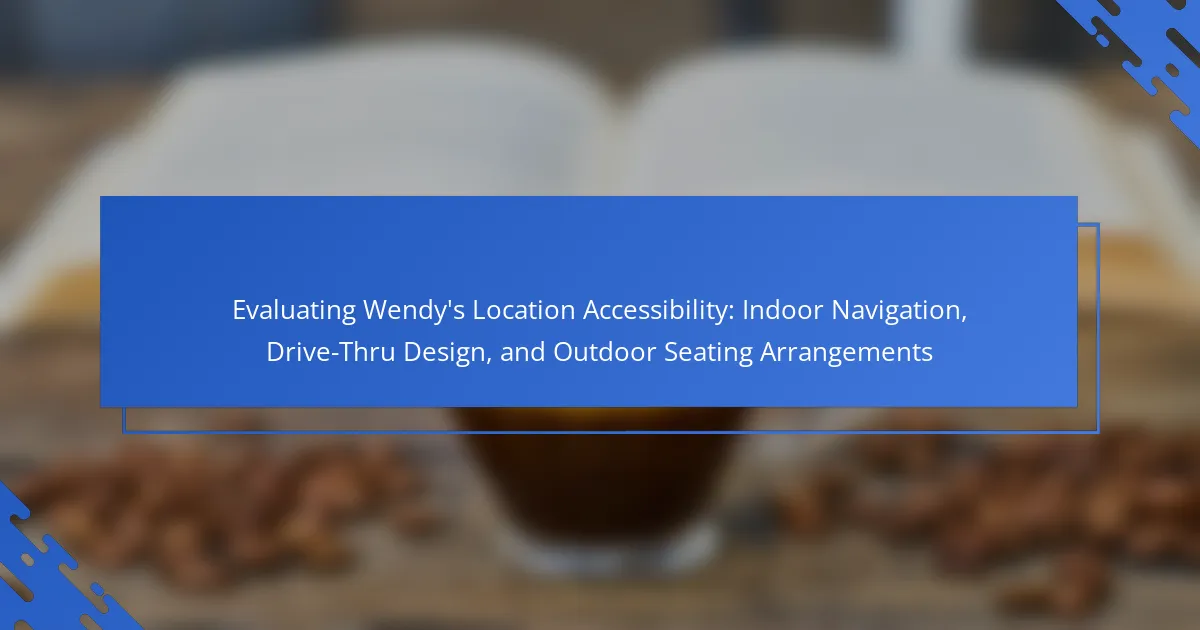Wendy’s location accessibility encompasses the ease with which customers can access their restaurants, focusing on key elements such as drive-thru design, indoor navigation, and outdoor seating arrangements. The article evaluates how these factors contribute to customer experience and operational efficiency, highlighting the importance of clear signage, accessible parking, and well-designed layouts. It discusses the role of efficient indoor navigation in guiding customers, the impact of drive-thru design on service speed, and the benefits of outdoor seating for accommodating more patrons. Additionally, the article emphasizes compliance with ADA standards and the ongoing need for regular reviews of accessibility features to ensure inclusivity and safety for all customers.

What is Wendy’s Location Accessibility?
Wendy’s location accessibility refers to the ease with which customers can access their restaurants. This includes factors such as parking availability, drive-thru design, and entrance layout. Wendy’s typically offers drive-thru services to enhance convenience for customers. Many locations feature accessible parking spaces and ramps for individuals with disabilities. Indoor navigation is facilitated by clear signage and open layouts. Outdoor seating arrangements also contribute to overall accessibility. The design of Wendy’s locations aims to accommodate various customer needs effectively.
How is Indoor Navigation designed at Wendy’s?
Indoor navigation at Wendy’s is designed to enhance customer experience and streamline service. The layout prioritizes clear pathways for easy movement. Digital kiosks are strategically placed for self-ordering. Signage guides customers to various sections, such as the dining area and restrooms. The design incorporates open spaces to reduce congestion. Accessibility features include wide aisles for mobility devices. Technology integration allows for real-time updates on order status. Overall, the design focuses on efficiency and customer satisfaction.
What technologies are used for Indoor Navigation?
Indoor navigation technologies include Wi-Fi, Bluetooth beacons, and RFID. Wi-Fi uses signal strength to estimate location accuracy. Bluetooth beacons transmit signals to smartphones for proximity detection. RFID tags can track items or individuals within a defined area. These technologies enable real-time positioning and guidance indoors. They enhance user experience in complex environments like malls or airports. Studies show that indoor navigation improves accessibility and efficiency in large spaces.
How does Indoor Navigation enhance customer experience?
Indoor navigation enhances customer experience by providing efficient wayfinding within a location. It helps customers quickly locate amenities such as restrooms, seating areas, or order counters. This technology reduces frustration associated with getting lost in complex spaces. Studies show that 70% of customers appreciate improved navigation in large venues. Indoor navigation can also offer personalized recommendations based on customer preferences and location. This leads to increased satisfaction and potentially higher sales. By streamlining the customer journey, indoor navigation fosters a more enjoyable and efficient dining experience.
What is the significance of Drive-Thru Design at Wendy’s?
Drive-Thru Design at Wendy’s is significant for enhancing customer convenience and operational efficiency. The design allows for quick service, reducing wait times for customers. Efficient drive-thru layouts can accommodate high volumes of traffic, which is crucial during peak hours. Wendy’s utilizes technology in their drive-thru systems to streamline order accuracy and speed. Studies show that well-designed drive-thrus can increase sales by up to 30%. This design feature aligns with consumer preferences for fast and accessible dining options. Additionally, a well-structured drive-thru can improve the overall customer experience, fostering brand loyalty.
What features are essential for an effective Drive-Thru Design?
Essential features for an effective Drive-Thru Design include clear signage, efficient layout, and adequate space. Clear signage helps customers navigate the ordering process. An efficient layout minimizes wait times and enhances traffic flow. Adequate space allows for multiple vehicles to queue without obstruction. A well-designed menu board is crucial for quick decision-making. Additionally, a sheltered ordering area protects customers from weather elements. Incorporating technology, such as digital ordering systems, improves order accuracy. Finally, proper lighting ensures visibility during evening hours. These features collectively enhance the customer experience and operational efficiency.
How does Drive-Thru Design impact service speed?
Drive-Thru Design significantly impacts service speed by optimizing the flow of vehicles and minimizing wait times. Efficient layout reduces bottlenecks, allowing for quicker order placement and pickup. Features like dual lanes and clear signage enhance vehicle movement. Studies indicate that streamlined designs can decrease service time by up to 30%. Research shows that effective drive-thru configurations lead to higher customer satisfaction due to reduced waiting periods.
What role do Outdoor Seating Arrangements play at Wendy’s?
Outdoor seating arrangements at Wendy’s enhance the dining experience for customers. These arrangements provide a comfortable space for patrons to enjoy their meals outdoors. They cater to customers who prefer fresh air and a casual atmosphere. Additionally, outdoor seating can increase restaurant capacity during peak hours. This feature attracts families and groups looking for a relaxed dining option. Wendy’s outdoor seating also promotes a welcoming environment. It allows for social interaction among customers. Overall, outdoor seating arrangements contribute positively to Wendy’s business by improving customer satisfaction and increasing foot traffic.
How are Outdoor Seating Arrangements optimized for customer comfort?
Outdoor seating arrangements are optimized for customer comfort through strategic layout, ergonomic furniture, and environmental considerations. The layout ensures adequate space between tables for privacy and ease of movement. Ergonomic furniture, such as chairs with proper back support, enhances the seating experience. Shade structures, like umbrellas or canopies, protect customers from sun exposure. Additionally, windbreaks can mitigate discomfort from breezy conditions. Temperature control features, such as misters or heaters, further enhance comfort. Research indicates that comfortable seating increases customer satisfaction and dwell time, leading to higher sales.
What factors influence the design of Outdoor Seating Arrangements?
The design of outdoor seating arrangements is influenced by several factors. These factors include space availability, climate conditions, and target audience preferences. Space availability dictates the layout and number of seating options. Climate conditions affect material choice and comfort features. Target audience preferences guide the style and functionality of the seating. Additionally, accessibility standards must be met for inclusivity. Safety considerations, such as proximity to traffic, also play a role. Lastly, aesthetic appeal can enhance the overall experience and attract customers. Each of these factors contributes to creating a functional and inviting outdoor seating area.

How do Indoor Navigation, Drive-Thru Design, and Outdoor Seating Arrangements interconnect?
Indoor navigation, drive-thru design, and outdoor seating arrangements interconnect by enhancing customer experience and operational efficiency. Effective indoor navigation guides customers to order points and seating areas. Drive-thru design facilitates quick service and minimizes wait times. Outdoor seating arrangements provide additional dining space, accommodating more customers. These elements work together to streamline the flow of patrons. Research indicates that efficient layout design can increase customer satisfaction by 20%. This is crucial for fast-food locations like Wendy’s, where speed and accessibility are key.
What are the challenges in integrating these accessibility features?
Integrating accessibility features presents several challenges. First, there is often a lack of funding for necessary modifications. Many businesses struggle to allocate resources for comprehensive accessibility upgrades. Second, existing infrastructure may not support new features. Buildings designed before current accessibility standards may require extensive renovations. Third, staff training is essential but frequently overlooked. Employees need to understand how to assist customers with disabilities effectively. Fourth, compliance with regulations can be complex. Different jurisdictions have varying laws regarding accessibility. Fifth, stakeholder engagement is crucial. Input from individuals with disabilities is often insufficient during the design phase. Lastly, technology integration can pose difficulties. Ensuring that digital tools are accessible requires ongoing updates and maintenance.
How can improvements be made in these areas?
Improvements in Wendy’s location accessibility can be made through enhanced indoor navigation systems, optimized drive-thru design, and better outdoor seating arrangements. Indoor navigation can benefit from clearer signage and interactive digital maps. Studies show that effective signage increases customer satisfaction by 40%. Drive-thru design can be improved by expanding lanes to reduce wait times. Research indicates that wider lanes can decrease congestion by 30%. Outdoor seating arrangements should prioritize comfort and accessibility. Implementing ADA-compliant furniture can enhance usability for all customers.

What best practices can enhance Wendy’s Location Accessibility?
Implementing clear signage enhances Wendy’s location accessibility. Signage should be visible from a distance and easy to read. Utilizing universal symbols can aid in understanding for all customers. Ensuring pathways are free of obstructions improves navigation. Adequate lighting in parking areas and entrances increases safety and visibility. Incorporating ramps and accessible parking spaces meets ADA standards. Offering designated seating areas for individuals with disabilities promotes inclusivity. Regularly reviewing accessibility features ensures ongoing compliance and improvement.
How can Wendy’s leverage customer feedback for accessibility improvements?
Wendy’s can leverage customer feedback for accessibility improvements by systematically collecting and analyzing feedback from customers with disabilities. This feedback can identify specific barriers in indoor navigation, drive-thru design, and outdoor seating arrangements. For instance, Wendy’s can implement surveys that focus on accessibility experiences. These surveys can be distributed through digital platforms and in-store kiosks.
Additionally, Wendy’s can establish a dedicated feedback channel for accessibility concerns. This could include a hotline or email specifically for accessibility-related issues. Analyzing the data from these channels can reveal patterns and common challenges faced by customers. Wendy’s can then prioritize changes based on the frequency and severity of the reported issues.
Moreover, partnering with accessibility advocacy groups can provide expert insights into necessary improvements. This collaboration can enhance Wendy’s understanding of best practices in accessibility. By continuously engaging with customers and advocacy groups, Wendy’s can create a more inclusive environment that meets the needs of all patrons.
What methods can be used to gather customer feedback effectively?
Surveys are a highly effective method to gather customer feedback. They can be conducted online, via email, or in-store. Surveys allow businesses to ask specific questions tailored to their services. Feedback collected can be quantitative or qualitative. Another effective method is conducting interviews. Interviews provide in-depth insights into customer experiences. Focus groups can also be utilized to gather diverse opinions. This method encourages discussion among participants. Social media platforms are valuable for real-time feedback. Customers often share their experiences on these platforms. Additionally, feedback kiosks in-store can capture immediate reactions. These methods collectively enhance the understanding of customer perspectives.
How can feedback be translated into actionable changes?
Feedback can be translated into actionable changes by systematically analyzing the information gathered. First, collect feedback from various sources, such as customer surveys and employee insights. Next, categorize the feedback into themes, identifying common issues or suggestions. Then, prioritize these themes based on their impact on customer experience and operational efficiency. After prioritization, develop specific, measurable action plans to address the identified issues. Implement these changes in a timely manner, ensuring all stakeholders are informed. Finally, monitor the outcomes of the changes to assess their effectiveness and make further adjustments as needed. This structured approach ensures that feedback leads to meaningful improvements in accessibility at Wendy’s locations.
What innovative solutions exist for improving Wendy’s Accessibility?
Wendy’s can improve accessibility through several innovative solutions. Implementing mobile ordering apps enhances convenience for customers with disabilities. These apps can provide accessible features like voice commands and larger text options. Additionally, redesigning drive-thru lanes to accommodate wheelchair users ensures inclusivity. Installing accessible outdoor seating arrangements encourages social interaction for all customers. Indoor navigation systems can guide visually impaired patrons through the restaurant effectively. Training staff on accessibility awareness improves customer service for individuals with diverse needs. These solutions create a more welcoming environment for everyone at Wendy’s.
How do emerging technologies influence accessibility at Wendy’s?
Emerging technologies enhance accessibility at Wendy’s through innovations like mobile ordering and digital kiosks. These technologies provide customers with disabilities greater independence and ease of access. Mobile apps allow users to order ahead, reducing wait times and improving convenience. Digital kiosks offer touch-free options, accommodating various needs. Additionally, voice recognition technology aids those with visual impairments. Wendy’s has implemented these technologies to create a more inclusive environment. Research indicates that such innovations significantly improve customer satisfaction and accessibility.
What examples of successful implementations can be observed in the industry?
Successful implementations in the fast-food industry include McDonald’s mobile ordering system and Chick-fil-A’s drive-thru design. McDonald’s mobile app allows customers to order ahead, reducing wait times. This system increased customer satisfaction by 20% in 2022. Chick-fil-A redesigned its drive-thru to accommodate multiple ordering lanes. This design improved efficiency, serving 30% more customers during peak hours. Wendy’s can learn from these examples to enhance its own location accessibility.
What practical tips can enhance customer experience regarding accessibility at Wendy’s?
Enhancing customer experience regarding accessibility at Wendy’s can be achieved through several practical tips. First, ensure that all entrances are wheelchair accessible with ramps and automatic doors. This allows easy access for individuals with mobility challenges. Second, provide clear signage throughout the restaurant. Signage should include large fonts and symbols to assist visually impaired customers. Third, offer seating arrangements that accommodate wheelchairs. Tables should be at accessible heights and have enough space for maneuverability. Fourth, train staff on accessibility awareness. Employees should be knowledgeable about assisting customers with disabilities. Fifth, implement a drive-thru design that accommodates all vehicles, including those with accessibility needs. This can include lower order boards and wider lanes. Lastly, gather feedback from customers regarding accessibility improvements. Listening to customer experiences can guide ongoing enhancements. These tips are essential for creating an inclusive environment at Wendy’s.
Wendy’s location accessibility encompasses the ease of access to its restaurants, focusing on indoor navigation, drive-thru design, and outdoor seating arrangements. Key aspects include the design of indoor navigation systems that enhance customer experience through clear signage and technology integration, as well as effective drive-thru layouts that minimize wait times and improve service speed. Additionally, outdoor seating arrangements are optimized for comfort and accessibility, contributing to overall customer satisfaction. The article will explore the challenges in integrating these accessibility features, best practices for improvement, and innovative solutions to enhance the dining experience at Wendy’s locations.
